This is the final set of data from the Timberline Trail survey results. You can read the results for the first two sets of data:
On to the final set of data results from the Timberline Trail survey!
Did you complete your hike as planned?

For the vast majority of hikers, their trip went as planned. For about 10% some issues occurred that were not planned. We will take a look at some of these in a short while.
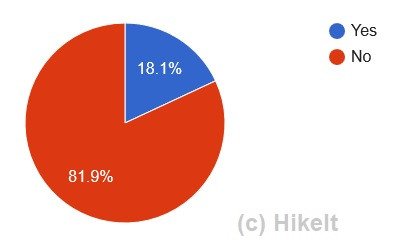
Perhaps the hardest decision to make on a hike that takes some preparation is whether to leave the trail early. This could be for a variety of reasons. However, often leaving the trail is a wise decision rather than pushing on and potentially making a situation worse.
Almost 20% of hikers decided to leave the trail early for some reason. On the Timberline Trail, there are several good exit points all around the mountain – however, some of these can leave you at a trailhead that is a long way from where you started. Trailheads on the northern side of Mount Hood can be particularly remote – Vista Ridge and Elk Cove.
Just around 3% of hikers had to call either SAR or other emergency services. Hopefully, everything worked out in the end for these hikers. And although distressing, calling SAR early rather than creating a more difficult situation is always a good approach. It’s important to remember that on Mount Hood there is no charge for a SAR callout – although if you are transported from the trailhead to a medical facility by a private service then, of course, there is.
Did you have any of the following problems?
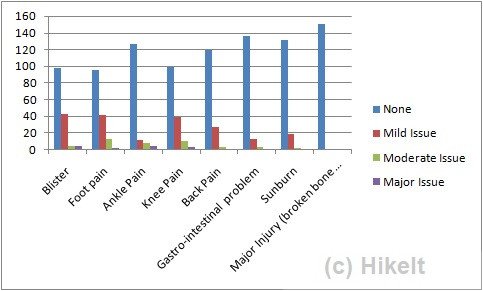
What were the most common problems that hikers had? Luckily there were not many moderate or major issues reported. Amongst the most common complaints were mild issues with blisters, foot and knee pain. Foot and knee pain also lead the group in terms of moderate issues.
Luckily there were very few major issues reported. These can be debilitating and again include blisters and lower leg issues. Unfortunately, there was one major injury reported.
Within this section of problems that caused hikers’ problems, there was also a comment section for other comments. In terms of other issues that were reported, these were the most common:
- Scratches and bruises from falls
- Cramps
- Nausea
- Flare-ups of old injuries
- Thigh chafing
Some questions on camping etiquette?
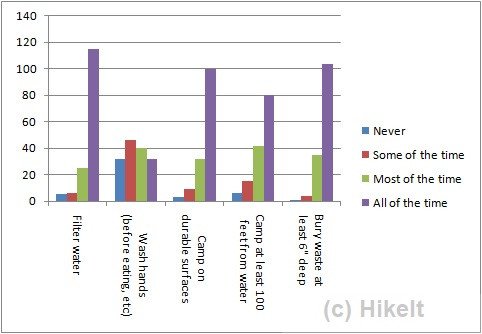
As the Timberline Trail gets busier, and backpacking becomes more popular, good trail etiquette can help make the experience more pleasant for all hikers, as well as ensure the trail stays in good condition for years to come.
Looking at each of these:
- Filter Water – by now most hikers are aware of the recommendation to filter water. Admittedly this question could be clearer to state any type of water treatment – even so, I am surprised that the answer to this question is not closer to everyone filtering their water. There are some locations where I would be less worried – for example in the High Sierra – however, there are fewer locations around Mount Hood where I would be comfortable without filtering water.
- Wash Hands – a very reliable hiking expert (Inga Aksamit) would be somewhat shocked by this result. Her recommendation is to always wash hands before eating. I’ll see if there is a correlation later between not washing hands and having gastrointestinal issues.
- Camping on durable services – this is one of the principles of LNT. As are the rest of the questions in this category. Generally, there are plenty of durable surfaces around Mount Hood to camp on. Although hikers did find it harder to find tent sites this year. Often meandering a little way off the trail can also find some great campsites on durable surfaces.
- Camp at least 100′ from water – often there are established campsites that are closer to water and this could account for camping closer to water, rather than establishing a new campsite
- Bury Waste – there has been increasing concern around Mount Hood, and in many of the other areas, about the increase in human waste and toilet paper ‘blooms’. For the benefit of all hikers, folks should be looking to bury their waste and their TP (if they are not going to carry it out) at least 6″ deep. No hiker wants to come across human waste on the trail.
Hopefully, hikers answered this set of questions honestly and it gives good insight into how we can all become more aware of how to make hiking on the trail more sustainable.
Did you bury or carry out your TP?

Following on from the question above, it is refreshing to see so many people carrying out their TP. In some hiking areas, this is already mandatory and I can see this trend continuing over time as backpacking increases in popularity. Personally, I am a big fan of the backcountry bidet and glad to see its use by almost 10% of the hikers.
However, that still leaves about 1/2 of the hikers burying their TP.
How was finding a campsite?

Overall about a quarter of hikers found some difficulty in finding a campsite. There were also some comments that also stated that finding a campsite was difficult. There are certainly some very popular areas and there is also increased information on where campsite locations are. These can lead to overcrowding. However, it is also not difficult to leave the trail at almost any location and find a suitable campsite on a durable surface.
With a little bit of exploration, you can find some great campsites that can often be away from the crowds.
Into the home stretch – the last set of questions were all demographic questions. Let’s see who it was who hiked the trail this year.
How old are you?

Maybe surprisingly the median age was in the 40’s. I would have expected this to be slightly younger. I am going to suspect that the lack of responses from those under 20’s is maybe more due to how I reached out to the hiking community – which was predominantly through Facebook groups, and the occasional posts through Reddit. Maybe in the future, I need to look at reaching a broader group through other channels.
It’s great to see a good contingent of older hikers as well. Having said that I first completed the Timberline Trail in my early 50’s and then again a few years later. I certainly hope to be able to complete it many more times before I hang up my hiking shoes!
Are you male or female?

Firstly, this question got the most feedback of any to extend it to include other options, in particular for our non-binary hikers. So this is an update I’ll make next year.
There is almost an even split between male and female.

The primary reason that I asked the question about race is that there is an ongoing discussion about inclusivity in outdoor recreation. Indeed recently Mount Hood National Forest proposed to increase certain fees associated with both climbing Mount Hood and several of the recreation sites around Mount Hood. This led to an interesting conversation in one of their town hall meetings as to what impact this would have on inclusivity.
Are you from the US?
It’s no surprise that the majority of hikers are from the US. 4 reported to be from Canada. From those who came from the US, there was also a tendency for them to be from the local area, although the Timberline Trail attracted hikers from all over the US.


And finally some comments
- Wonderful helpful people on trail – many willing to help with crossings for safe fording or guidance on where to cross. Facebook group is absolutely invaluable too.
- It was harder than expected. Packs were just too heavy with the bear canisters.
- Building a strategy for the crossings was interesting. After a challenging late afternoon Eliot crossing we decided to camp an extra night so we could time our White crossing for the early morning.
- Don’t go up/down the scree hill into Eliot as a group, go ONE AT A TIME. Disaster waiting to happen from what I’ve witnessed.
- River crossings were much harder this year than when I did them 5 years ago. The scramble at Eliot was very sketchy! The detour could be better marked (going ccw, the tree the detour sign is posted on is confusing for determining which trail to follow and the sign to turn left onto the pct after Ramona falls was easy to miss!).
- It was really hard but very enjoyable. Beautiful.
- The wildflowers and various views were amazing! Crossed all major streams before 12
- Trekking poles were life savers – if doing CCW, the last day will be a killer in terms of eval gain.
- Beautiful trail with amazing signage and trail markings (especially the cairns around river crossings). The hardest part was getting both down and back up from the Eliot. The crossing itself was no big deal!
- It’s okay to get your feet wet. Trying to rock-hop can cause more problems, so people need to know it’s okay to get your feet wet.
- I love this trail. Highlights were the incredible visibility, a smoke-free view is really something. I also love the changing views of the mountains, flora and fauna, and trail. Tips? Be prepared – know your gear. Be fit and ready for long days if necessary. And, relax and enjoy the wonderment of nature.
And finally…
Thank you to everyone who answered the Timberline Trail survey! I hope to keep this up in the years moving forward so that I can also look at trend data. There was some excellent feedback on how to improve the survey in future years – thanks for that.
For this year’s Timberline Trail survey, I’ll make a final post with some interesting analysis of the data – such as when mosquitoes stopped being a problem, and whether there is any correlation between injuries and other factors such as pack weight or shoe type. Finally, I’d like to make a statistical summary for the Forest Service. The Forest Service provides an amazing service and hopefully, this data will help them in some of their decision-making processes.

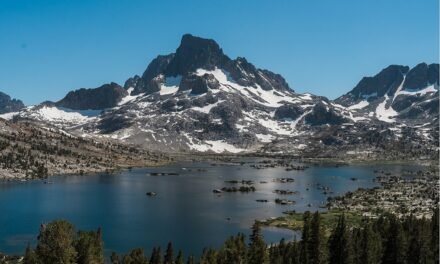

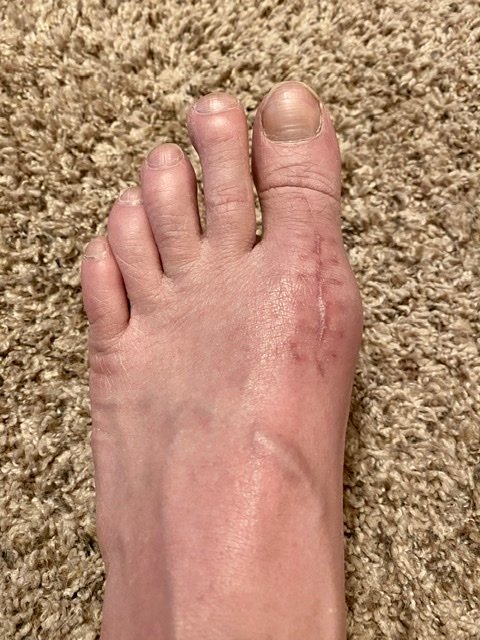


Trackbacks/Pingbacks